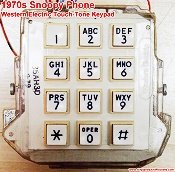Electronics & Technology
- See Full List of AI Topics -

DTMF Touchtone keypad from vintage Snoopy telephone.
Dual Tone Multiple Frequency
(DTMF) signaling, often known as "touch-tone" dialing, is a method for transmitting
telecommunication signals using two simultaneous audio frequencies to represent
each digit on a telephone keypad. This technology was invented in the early 1960s
by engineers at Bell Labs, particularly by John E. Goode and his team, who sought
a more efficient and reliable method for dialing telephone numbers than the traditional
rotary dial system. DTMF was introduced to the public in 1963 and became the standard
for push-button telephones, transforming telecommunication systems and enabling
more sophisticated interaction with automated systems.
The fundamental principle behind DTMF is based on the generation of two audio
frequencies for each key press. The tones are selected from two different frequency
groups, high and low, and each key corresponds to a unique combination of one frequency
from each group. This pairing of frequencies allows each button on a keypad to transmit
a distinct sound, unambiguously identifying each digit or symbol pressed. The key
frequencies were chosen carefully to minimize the risk of interference, ensure clarity
of transmission, and prevent harmonics that could create ambiguous signals.
DTMF frequencies are divided into two bands. The low-frequency group includes
697 Hz, 770 Hz, 852 Hz, and 941 Hz, while the high-frequency group includes 1209
Hz, 1336 Hz, 1477 Hz, and 1633 Hz. Each button on a keypad represents a combination
of one low and one high frequency, generating a unique dual-tone signal when pressed.
The standard arrangement for frequencies on a 4x4 DTMF keypad is as follows:
Row frequencies (low):
- First row (697 Hz): 1, 2, 3, A
- Second row (770 Hz): 4, 5, 6, B
- Third row (852 Hz): 7, 8, 9, C
- Fourth row (941 Hz): *, 0, #, D
Column frequencies (high):
- First column (1209 Hz): 1, 4, 7, *
- Second column (1336 Hz): 2, 5, 8, 0
- Third column (1477 Hz): 3, 6, 9, #
- Fourth column (1633 Hz): A, B, C, D
Each button press generates a signal s(t) that is the sum of the low-frequency
fL and high-frequency fH components. The equation for the
tone generated by pressing a single key is:
s(t) - sin (2πfLt) + sin(2πfHt),
where fL and fH are the low and high frequencies associated
with the specific key, and t is time. This combination of two distinct
frequencies allows the signal to be accurately interpreted at the receiving end,
even with considerable background noise, because each pair is unique within the
system. The DTMF signal remains within the audible frequency range, making it ideal
for transmission over traditional telephone lines.
DTMF's advantages over pulse dialing, the method used with rotary phones, include
faster transmission, more efficient handling of automated switching systems, and
increased reliability. Pulse dialing relied on mechanical pulses generated by rotating
a dial, which was both time-consuming and error-prone, particularly with long-distance
calls. DTMF tones transmit nearly instantaneously and provide a straightforward
digital method of identifying each pressed key. This system of signaling gained
immediate popularity, becoming a standard for telephony systems and helping to lay
the foundation for Interactive Voice Response (IVR) systems. DTMF is still widely
used today in telecommunication systems and many automated services, including banking,
customer service, and security systems.
Error correction and security in DTMF have always been critical considerations,
particularly as touch-tone dialing extended to remote access and automated systems.
One key challenge in DTMF transmission is the potential for errors due to interference,
distortion, or crosstalk in the phone lines. Modern DTMF decoders incorporate noise
filters to detect and minimize the impact of non-DTMF sounds and differentiate between
DTMF tones and other line noises. To maintain security, DTMF signals are typically
paired with additional verification methods when used in sensitive applications
such as banking. Secure DTMF solutions often employ encryption and automated checks
to prevent unauthorized access or signal spoofing, as DTMF tones could be recorded
and replayed to gain unauthorized access. As a result, additional technologies,
such as PIN codes and password protection, are combined with DTMF to ensure that
only the intended user can interact with sensitive systems.
The mathematical precision of DTMF is rooted in the unique, predefined frequency
pairs and the robust nature of its sine wave signal generation, which resists signal
degradation. A fundamental rule of DTMF is that each button is uniquely identified
by its specific two-tone combination, thus allowing for 16 different key values
(0-9, *, #, and the A-D keys on extended keypads). This design extends DTMF’s utility
for uses beyond dialing, enabling data entry and interaction with digital systems.
The frequencies used in DTMF were carefully chosen not to overlap with harmonics
or common signal interferences, which would distort the signal and reduce accuracy.
Additionally, each frequency in the DTMF spectrum is separated sufficiently from
the others to prevent misinterpretation by the receiving system.
The standardization of DTMF by the International Telecommunication Union (ITU)
under recommendation Q.23 and its adoption by various telephone companies made DTMF
a universally recognized system for signaling. This standardization has allowed
devices and systems from different manufacturers to interpret DTMF signals uniformly,
making it a fundamental communication protocol within and beyond telephony. DTMF
signaling became the foundation for various digital telecommunications technologies,
especially as it introduced early forms of digital interaction in voice-based communications.
The principles underlying DTMF are foundational in telecommunication systems, demonstrating
how sound-based signal transmission can create reliable communication protocols.
In recent years, although DTMF remains standard, advancements in telecommunications
have introduced alternatives. Voice-over-IP (VoIP) services and digital communication
systems sometimes employ in-band DTMF, where tones are transmitted as part of the
voice signal, or out-of-band DTMF, where the tones are digitally encoded and transmitted
separately from voice. These adaptations help preserve signal integrity and mitigate
the distortion that can arise in systems where traditional DTMF may not perform
optimally.
Overall, DTMF represents a critical evolution in telecommunication technology,
illustrating how a simple yet robust system based on audio frequencies could revolutionize
the speed and efficiency of dialing, data entry, and interaction with digital systems.
The invention by Bell Labs and subsequent refinement by telecom engineers led to
DTMF's dominance, with touch-tone signaling enabling new possibilities for automated
communication, remote access, and even early forms of digital control. This signaling
method is a testament to the power of frequency-based communication and the enduring
significance of dual-tone methods in telecommunications.
 This content was generated by primarily
the ChatGPT (OpenAI), and/or
Gemini (Google), and/or
Arya (GabAI), and/or
Grok (x.AI), and/or DeepSeek artificial intelligence (AI) engine.
Some review was performed to help detect and correct any inaccuracies; however,
you are encouraged to verify the information yourself if it will be used for critical
applications. In some cases, multiple solicitations to the AI engine(s) was(were) used to assimilate
final content. Images and external hyperlinks have also been added occasionally.
Courts have ruled that AI-generated content is not subject to copyright restrictions,
but since I modify them, everything here is protected by RF Cafe copyright. Many
of the images are likewise generated and modified. Your use of this data implies
an agreement to hold totally harmless Kirt Blattenberger, RF Cafe, and any and all
of its assigns. Thank you. Here are the major categories. This content was generated by primarily
the ChatGPT (OpenAI), and/or
Gemini (Google), and/or
Arya (GabAI), and/or
Grok (x.AI), and/or DeepSeek artificial intelligence (AI) engine.
Some review was performed to help detect and correct any inaccuracies; however,
you are encouraged to verify the information yourself if it will be used for critical
applications. In some cases, multiple solicitations to the AI engine(s) was(were) used to assimilate
final content. Images and external hyperlinks have also been added occasionally.
Courts have ruled that AI-generated content is not subject to copyright restrictions,
but since I modify them, everything here is protected by RF Cafe copyright. Many
of the images are likewise generated and modified. Your use of this data implies
an agreement to hold totally harmless Kirt Blattenberger, RF Cafe, and any and all
of its assigns. Thank you. Here are the major categories.
Electronics & High Tech
Companies | Electronics &
Tech Publications | Electronics &
Tech Pioneers | Electronics &
Tech Principles |
Tech Standards Groups &
Industry Associations | Societal
Influences on Technology
|









